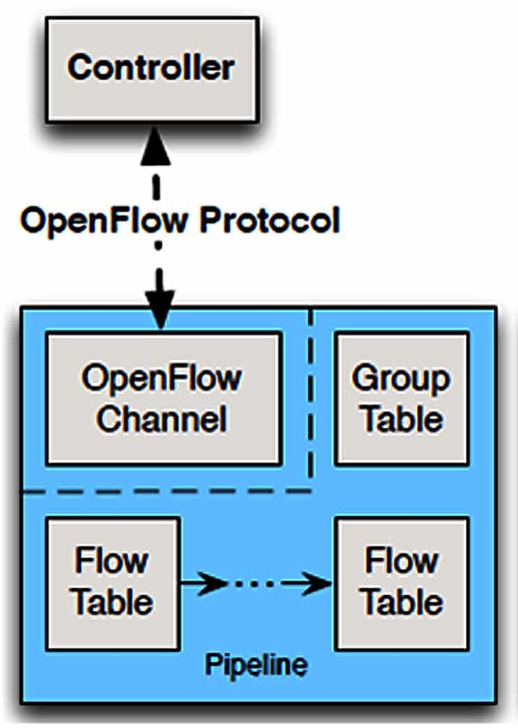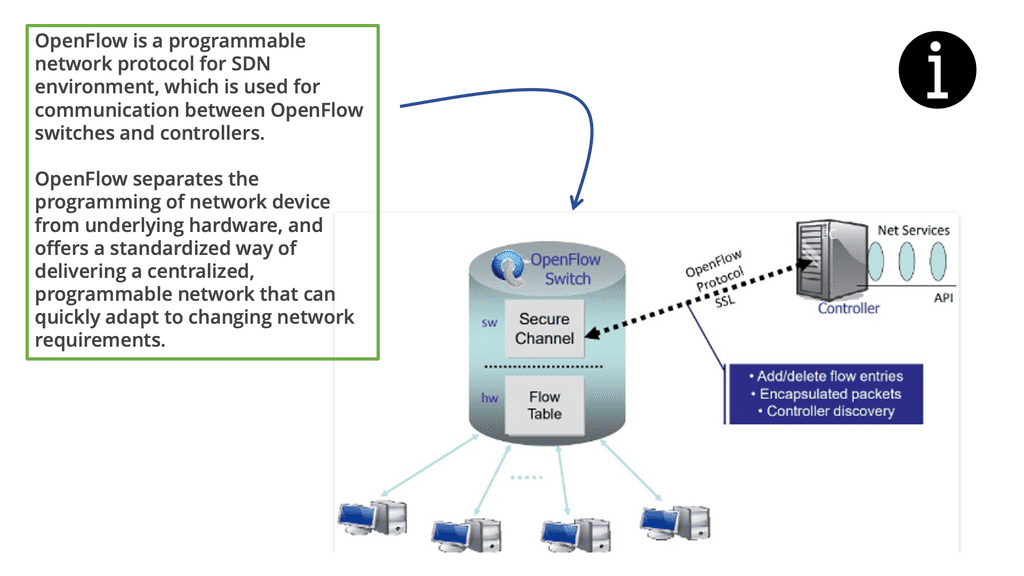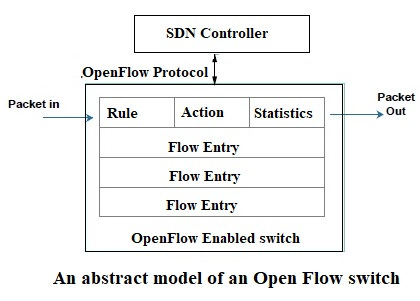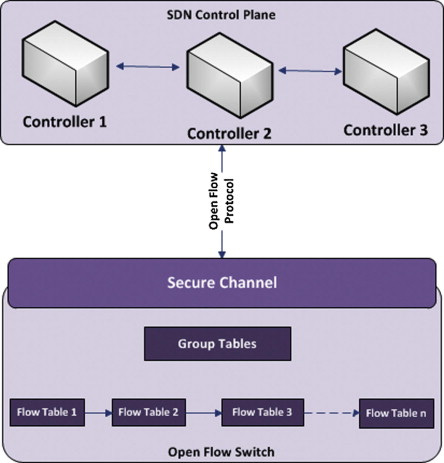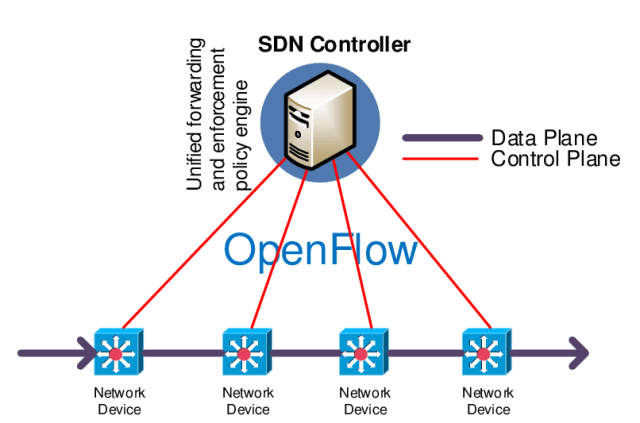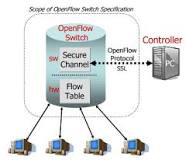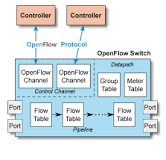OpenFlow
OpenFlow là một giao thức thuộc lĩnh vực Software-Defined Networking (SDN), cho phép kiểm soát mạng một cách linh hoạt thông qua việc tách biệt control plane và data plane. Việc hiểu rõ ưu nhược điểm, cũng như khả năng report của OpenFlow là rất quan trọng để áp dụng trong các môi trường mạng hiện đại như trong mạng quang GMPLS, hoặc các hệ thống mạng trong ADAS (Advanced Driver-Assistance Systems).
🌟 Ưu điểm của OpenFlow:
Centralized Control: Mạng có thể được điều khiển tập trung từ một controller duy nhất, giúp dễ dàng quản lý và cấu hình.
Dễ dàng triển khai và thay đổi: Việc thay đổi chính sách mạng, các quy tắc chuyển mạch hoặc hành vi routing trở nên dễ dàng hơn, không cần phải cấu hình từng thiết bị riêng lẻ.
Quản lý tập trung (SDN): OpenFlow có thể cung cấp thông tin phản hồi về trạng thái mạng ở cấp độ thiết bị, giúp tối ưu hóa hoạt động mạng và cho phép tự động hóa.
Hỗ trợ QoS và Traffic Engineering: OpenFlow giúp tối ưu băng thông và ưu tiên lưu lượng mạng dựa trên các tiêu chí nhất định.
Mạng mềm dẻo (flexible): Cung cấp khả năng điều chỉnh linh hoạt các chính sách mạng và điều chỉnh theo yêu cầu ứng dụng.
❌ Nhược điểm của OpenFlow:
Tính tương thích: OpenFlow không phải là một chuẩn mở hoàn toàn, và một số thiết bị không tương thích hoặc chỉ hỗ trợ OpenFlow một phần.
Overhead của Controller: Việc xử lý và quản lý qua controller có thể tạo ra độ trễ, đặc biệt trong mạng lớn.
Scalability: OpenFlow có thể gặp khó khăn trong việc mở rộng mạng quy mô lớn, do cần phải giữ kết nối giữa các switch và controller.
Độ trễ trong truyền tải: Nếu không có cấu hình phù hợp, độ trễ có thể xảy ra do cần phải gửi yêu cầu giữa các thiết bị và controller để thay đổi các flow table.
Hạn chế với các tính năng đặc biệt: Mặc dù OpenFlow hỗ trợ các chức năng cơ bản của chuyển mạch, nhưng lại hạn chế trong việc xử lý các chức năng mạng phức tạp, đặc biệt trong môi trường mạng quang (optical networks).
📊 Những gì OpenFlow có thể report:
Trạng thái Flow Table: Thông tin chi tiết về các flow hiện tại, bao gồm các dòng lưu lượng (flow entries), bộ lọc (match fields), hành động (actions), và số lượng packet đã xử lý.
Tình trạng kết nối của switch: Trạng thái của các switch (up/down), mức độ sử dụng băng thông, và các sự kiện báo lỗi.
Thông tin về Errors và Packets Drop: OpenFlow có thể báo cáo số lượng gói tin bị drop, lỗi trong quá trình chuyển mạch, hoặc các sự cố liên quan đến phần cứng của switch.
Thông tin về thống kê lưu lượng (traffic statistics): Bao gồm số lượng byte, gói tin, và thời gian xử lý các flow.
Switch Features: Thông tin về khả năng chuyển mạch của switch, ví dụ như hỗ trợ các loại chuyển mạch (Ethernet, MPLS, Tunnel, etc.).
❌ Những gì OpenFlow không thể report hoặc có giới hạn:
Thông tin về các ứng dụng và dịch vụ: OpenFlow không thể cung cấp thông tin chi tiết về các ứng dụng chạy trên mạng hoặc các service layer.
Mạng quang (Optical Networks): OpenFlow không thể trực tiếp quản lý các liên kết quang (optical links), vì vậy sẽ gặp khó khăn trong các mạng GMPLS hoặc mạng quang.
Chỉ báo phân tích chi tiết về bảo mật (Security): OpenFlow không phải là công cụ chính để phân tích các mối đe dọa bảo mật mạng.
Thông tin về nội dung dữ liệu: OpenFlow không thể báo cáo chi tiết về nội dung của dữ liệu trong gói tin, nó chỉ có thể báo cáo thông tin liên quan đến header và trạng thái lưu lượng.
Tính năng chuyển mạch nâng cao: Một số tính năng như chuyển mạch theo kiểu quang học, các tính năng mạng nâng cao (TDM, WDM), hoặc các chức năng đặc biệt cần phải sử dụng công nghệ khác hoặc bổ sung phần mềm điều khiển bổ sung.
🌐 Kết luận:
OpenFlow là một công cụ mạnh mẽ cho Software-Defined Networking (SDN), tuy nhiên, nó có những hạn chế nhất định trong môi trường mạng phức tạp, đặc biệt là đối với mạng quang hoặc những trường hợp yêu cầu các chức năng chuyển mạch đặc biệt. Nếu bạn đang làm việc trong một môi trường như GMPLS hoặc mạng quang, có thể cần kết hợp OpenFlow với các công nghệ khác để quản lý toàn diện và tối ưu hóa mạng.
OpenFlow and YANG serve distinct roles in networking, particularly within the context of software-defined networking (SDN) and network management. Here's a breakdown of their differences:
1. Purpose and Functionality
OpenFlow:
Role: A communication protocol in SDN.
Function: It enables a centralized SDN controller to communicate with network devices (like switches and routers) and dictate how packets should be forwarded.
Focus: Packet-forwarding decisions based on flow tables in devices.
Use Case: Real-time, dynamic control of network traffic and forwarding rules.
YANG:
Role: A data modeling language for network configuration and management.
Function: Provides a standard way to model and manipulate configuration data, operational data, and RPCs (Remote Procedure Calls) for network devices.
Focus: Structured data representation, typically used with protocols like NETCONF or RESTCONF for managing device configurations.
Use Case: Network automation and device configuration management.
2. Layer of Operation
OpenFlow:
Operates at the data plane and control plane.
Directly influences how packets are handled within the network.
YANG:
Operates at the management plane.
Focuses on how network devices are configured and monitored rather than on the live handling of network traffic.
3. Protocol Interaction
OpenFlow:
Works with SDN controllers (e.g., OpenDaylight, ONOS).
Specifies flow rules sent from the SDN controller to devices.
YANG:
Works with network management protocols (e.g., NETCONF, RESTCONF).
Defines schemas for structured configuration data (e.g., JSON, XML).
4. Examples of Usage
OpenFlow:
A controller using OpenFlow might install a rule to route video traffic through a specific link in the network to avoid congestion.
YANG:
A network administrator might use YANG models with NETCONF to configure VLANs, IP routes, or firewall rules on a router.
5. Maturity and Adoption
OpenFlow:
Widely known for being one of the first SDN-enabling protocols.
Its adoption has diminished in favor of broader SDN solutions and intent-based networking approaches.
YANG:
Increasingly adopted for modern network automation and programmability.
Actively used in multi-vendor environments for its standardization benefits.
Key Takeaway
OpenFlow focuses on dynamic, low-level traffic control, enabling centralized SDN control over packet forwarding.
YANG provides high-level, standardized data modeling to simplify device configuration and operational monitoring.
Both are complementary in SDN and modern networking environments but serve very different purposes.
Here’s a simple example of an OpenFlow configuration that demonstrates how to set up a flow rule in an OpenFlow-enabled switch. This example routes packets with a specific destination IP address through a particular output port.
Example: Configuring a Flow Rule
Scenario: Route packets with destination IP 192.168.1.10 out through port 3.
Basic Configuration Parameters:
Match Field: Destination IP address.
Action: Forward to a specific port.
Priority: Determines the rule's precedence (higher values take precedence).
Idle Timeout: Optional; specifies how long the flow entry should remain active without packets.
Hard Timeout: Optional; specifies the absolute lifetime of the flow entry.
Flow Rule in JSON Format (example for an OpenFlow controller like OpenDaylight or Ryu):
{
"dpid": 1,
"cookie": 1,
"table_id": 0,
"priority": 100,
"match": {
"eth_type": 2048,
"ipv4_dst": "192.168.1.10"
},
"actions": [
{
"type": "OUTPUT",
"port": 3
}
]
}
Steps:
Install Flow Rule:
Using an OpenFlow controller (e.g., Ryu, OpenDaylight), send this JSON configuration to the switch via the controller’s REST API.
Result:
Any incoming packet with a destination IP of
192.168.1.10will be forwarded to port3on the switch.
Explanation of the Configuration
dpid: Datapath ID of the switch (unique identifier for the OpenFlow switch).
cookie: A unique identifier for tracking the flow rule.
table_id: Indicates the flow table within the switch (default is 0).
priority: The priority of the rule. Higher priority rules are evaluated first.
match: The matching conditions for the flow. Here, we match packets based on their destination IP.
actions: The action to take if the match conditions are met. In this case, forward the packet to port
3.
Tools to Test:
Mininet: Simulate an OpenFlow-enabled network.
Ryu Controller: Programmatically control OpenFlow switches.
Wireshark: Verify flow behavior by capturing and analyzing traffic.
This is a simplified demonstration of OpenFlow in action. Real-world configurations can include more complex match fields (e.g., VLAN tags, TCP/UDP ports) and multiple actions (e.g., packet modification, drop).
OpenFlow is used by various networking vendors as part of their Software-Defined Networking (SDN) solutions. Below are some of the major vendors and their products or platforms that support OpenFlow:
Vendors Using OpenFlow
Cisco
Platform: Cisco Open SDN Controller (based on OpenDaylight)
Notes: While Cisco initially supported OpenFlow in some products, their focus has shifted toward proprietary SDN solutions like Cisco ACI (Application Centric Infrastructure).
Juniper Networks
Platform: Contrail SDN platform and OpenFlow-enabled switches (e.g., EX series).
Notes: Offers partial OpenFlow support, integrated with its SDN and automation frameworks.
Hewlett Packard Enterprise (HPE)
Platform: HPE FlexNetwork architecture (e.g., HP 3800 series switches).
Notes: One of the early adopters of OpenFlow, with strong integration in campus and data center switches.
Arista Networks
Platform: Arista EOS (Extensible Operating System).
Notes: Provides OpenFlow support as part of its SDN capabilities in data centers.
Extreme Networks
Platform: OpenFlow-enabled switches and SDN solutions.
Notes: Supports OpenFlow for network automation and policy control.
NEC
Platform: ProgrammableFlow Controller.
Notes: A pioneer in OpenFlow adoption, focusing on creating OpenFlow-based SDN solutions for enterprises.
Dell Technologies
Platform: Dell Networking S-Series switches.
Notes: Offers OpenFlow support, especially in their open networking switches.
Nokia (Alcatel-Lucent)
Platform: Nuage Networks SDN platform.
Notes: Incorporates OpenFlow as part of its SDN framework, especially for network automation.
Huawei
Platform: Agile Controller and CE switches.
Notes: Includes OpenFlow support within its SDN offerings, targeting enterprise and service provider markets.
Ciena
Platform: Blue Planet SDN Controller.
Notes: Uses OpenFlow for managing optical and packet-based network solutions.
OpenFlow Adoption in Open Source Platforms
Some open-source platforms also use OpenFlow, often acting as controllers for SDN environments:
OpenDaylight
ONOS (Open Network Operating System)
Ryu
Declining OpenFlow Adoption
While OpenFlow was one of the foundational technologies of SDN, its adoption has declined in recent years. Many vendors have shifted toward more comprehensive SDN solutions using protocols like NETCONF/YANG, P4, or proprietary APIs, citing limitations in OpenFlow for handling complex network scenarios.


